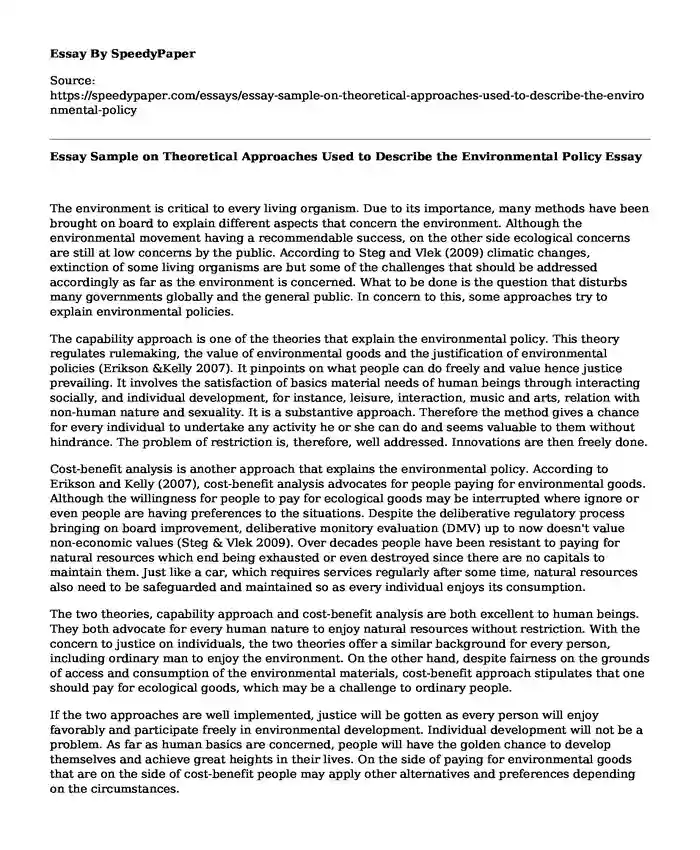
| Type of paper: | Research paper |
| Categories: | Policy Environment |
| Pages: | 3 |
| Wordcount: | 628 words |
The environment is critical to every living organism. Due to its importance, many methods have been brought on board to explain different aspects that concern the environment. Although the environmental movement having a recommendable success, on the other side ecological concerns are still at low concerns by the public. According to Steg and Vlek (2009) climatic changes, extinction of some living organisms are but some of the challenges that should be addressed accordingly as far as the environment is concerned. What to be done is the question that disturbs many governments globally and the general public. In concern to this, some approaches try to explain environmental policies.
The capability approach is one of the theories that explain the environmental policy. This theory regulates rulemaking, the value of environmental goods and the justification of environmental policies (Erikson &Kelly 2007). It pinpoints on what people can do freely and value hence justice prevailing. It involves the satisfaction of basics material needs of human beings through interacting socially, and individual development, for instance, leisure, interaction, music and arts, relation with non-human nature and sexuality. It is a substantive approach. Therefore the method gives a chance for every individual to undertake any activity he or she can do and seems valuable to them without hindrance. The problem of restriction is, therefore, well addressed. Innovations are then freely done.
Cost-benefit analysis is another approach that explains the environmental policy. According to Erikson and Kelly (2007), cost-benefit analysis advocates for people paying for environmental goods. Although the willingness for people to pay for ecological goods may be interrupted where ignore or even people are having preferences to the situations. Despite the deliberative regulatory process bringing on board improvement, deliberative monitory evaluation (DMV) up to now doesn't value non-economic values (Steg & Vlek 2009). Over decades people have been resistant to paying for natural resources which end being exhausted or even destroyed since there are no capitals to maintain them. Just like a car, which requires services regularly after some time, natural resources also need to be safeguarded and maintained so as every individual enjoys its consumption.
The two theories, capability approach and cost-benefit analysis are both excellent to human beings. They both advocate for every human nature to enjoy natural resources without restriction. With the concern to justice on individuals, the two theories offer a similar background for every person, including ordinary man to enjoy the environment. On the other hand, despite fairness on the grounds of access and consumption of the environmental materials, cost-benefit approach stipulates that one should pay for ecological goods, which may be a challenge to ordinary people.
If the two approaches are well implemented, justice will be gotten as every person will enjoy favorably and participate freely in environmental development. Individual development will not be a problem. As far as human basics are concerned, people will have the golden chance to develop themselves and achieve great heights in their lives. On the side of paying for environmental goods that are on the side of cost-benefit people may apply other alternatives and preferences depending on the circumstances.
While addressing globalization and world politics, the capability approach can best be used. This approach provides for fairness, which results in democracy (Erikson &Kelly 2007). Via freedom, world politics will be well conducted. Every individual will have an equal chance to participate in politics and globalization. Incapability theory, it states that an individual can do what he or she wants. This paves the way for innovations which result in improvement in globalization.
References
Erikson, S. H., &Kelly, P.M.(2007). Developing credible vulnerability indicators for climate adoption policy assessment. Mitigation and adoption strategies for global change, 12(4), 495-524
Steg, L., & Vlek, C. (2009). Encouraging pro-environmental behavior: an integrative review and research agenda. Journal of environmental psychology, 29(3), 309-317.
Cite this page
Essay Sample on Theoretical Approaches Used to Describe the Environmental Policy. (2023, Jan 31). Retrieved from https://speedypaper.net/essays/essay-sample-on-theoretical-approaches-used-to-describe-the-environmental-policy
Request Removal
If you are the original author of this essay and no longer wish to have it published on the SpeedyPaper website, please click below to request its removal:
- Indentured Servitude and Colonial Labor - AP US History Essay Sample
- Essay Example: The Causes of Environmental Pollution
- Free Essay on the Characteristics of a Good Holistic Leader
- Audit and Assurance Essay Example
- Essay Sample on Regulating Advertising Practices
- Prevention of School Violence - Research Paper Example
- Essay Sample on Emergency Operation Plan Summary
Popular categories




